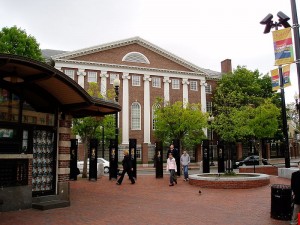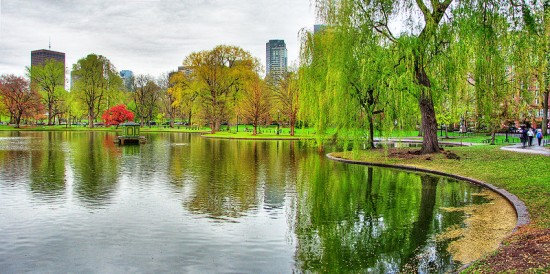George Burden pays a visit to one of the most fascinating and historically significant cities in the United States — Boston, Massachusetts.
Twenty-four-year-old George Burden moved to Boston in October of 1635. His trip from England aboard the Abigail was marred by a smallpox outbreak. Despite this, he managed to become a successful miller and ended up owning a good chunk of the north end of the city.
Three hundred and seventy one years later, George Burden, the author (that’s me) made his first trip to Boston in somewhat greater comfort (excepting perhaps the food) aboard an Air Canada commuter jet. Had the property remained in the family, I would likely have been flying in my own jet.
Arriving on an unusually balmy November day I grabbed a cab at Boston’s Logan Airport and made my way to the Fairmont Copley Plaza. This opulent hotel, built in 1902, reminded me of the Hofberg Palace in Vienna with its multitude of chandeliers, gilt walls and frescoed ceilings. The Fairmont’s location was perfect for exploring the city further, with Copley Square a reasonable walk from the Boston Commons and the start of the historic Freedom Trail. But first I ascended 50 floors of the nearby Prudential building to the “Skywalk Observatory” for a 360-degree aerial view of the city and its environs.
Boston reminds me a great deal of a larger version of Halifax, both being located on a peninsula and starting life as British colonial cities. The Bostonians, however, are inordinately proud of having booted the British out of their city during the American Revolution. Nevertheless, the two cities have retained close ties for several centuries and when Nova Scotia’s capital city suffered major devastation in the 1917 Halifax Explosion, the first major source of relief came from Boston. To this day, every Christmas, Nova Scotia thanks Boston by sending a huge Christmas tree to grace its Commons.
Fortuitously, I arrived  at the Boston Commons at exactly the same time as this year’s tree and witnessed a lone bagpiper serenading the imported greenery. Afterwards, I commenced the nearby Freedom Trail, a clearly marked path of red brick that leads the tourist to some of the most important historic sites.
at the Boston Commons at exactly the same time as this year’s tree and witnessed a lone bagpiper serenading the imported greenery. Afterwards, I commenced the nearby Freedom Trail, a clearly marked path of red brick that leads the tourist to some of the most important historic sites.
The first part of the journey was guided by Rudy, a costumed animator who assumed the role of Captain John Decoster, one of the residents of the nearby Old Granary Burial Ground. He bluffly introduced some of the more illustrious inhabitants of the cemetery including Paul Revere, John Hancock and Samuel Adams (the latter, like Halifax’s Alexander Keith, now more renowned for giving his name to a brand of ale). The good Captain recounted that Adams was actually the “spin doctor” of the American Revolution. The so-called Boston Massacre killed only five civilians, and was triggered by a member of the unruly crowd of Bostonians shouting “Fire!” at nervous British soldiers with loaded muskets. Adams, playing a little free and easy with the details, was able to use this as favorable propaganda for revolution.
Our guide further explained how Revere’s famous midnight ride was initiated by a lantern displayed in the steeple of the Old North Church (“one if by land and two if by sea”). However, he did not shout, “The British are coming!” as Longfellow suggested in his famous poem, “The Midnight Ride of Paul Revere.” He actually cried, “The Regulars are out!” Longfellow, realizing this sounded more like closing time at the local tavern, invoked his poetic license.
There were also in reality three riders who warned of the advent of the Redcoats, but Revere, being a better silversmith than horseman, was the one captured by the British. About to be executed, he tried to bluff a portly British major into believing that five hundred troops were at that very moment approaching to rescue him. By odd coincidence, a group of very cold Patriots (or Rebels depending on your perspective) decided at this moment to take a break at a local drinking establishment. It being illegal to enter with a loaded musket, they simultaneously discharged their guns into the air, scaring off the British and preventing Revere’s execution.
Further up the trail we visited the Old South Meeting Hall which was the starting point for the Boston Tea Party. Next we passed the Old State House, once the seat of British Government and from where the “Declaration of Independence” was first read. In the traffic island in front of this building a brick circle marks the site of the Boston Massacre. Further on we encountered Faneuil Hall, an historic meeting and market place and passed the Union Oyster House, the USA’s oldest restaurant. From there it was on to Paul Revere’s home and then to the Old North Church.
 Crossing the Charles River I entered the Charlestown Shipyard and boarded the U.S.S. Constitution, fondly known as “Old Ironsides”, the most venerable commissioned vessel in the U.S. Navy. Its “live oak” hull was so dense that cannon balls literally bounced off it. Due to the small end-of-season groups, the young seamen conducting the tour took us into the officer’s quarters and captain’s cabin of the ship, areas that few normally get to see.
Crossing the Charles River I entered the Charlestown Shipyard and boarded the U.S.S. Constitution, fondly known as “Old Ironsides”, the most venerable commissioned vessel in the U.S. Navy. Its “live oak” hull was so dense that cannon balls literally bounced off it. Due to the small end-of-season groups, the young seamen conducting the tour took us into the officer’s quarters and captain’s cabin of the ship, areas that few normally get to see.
The Constitution Museum is worth a look, and afterwards I’d recommend taking the Water Shuttle back into the city. It costs a $1.50 and gives an excellent look at the Boston skyline, making it the cheapest harbor tour around. The shuttle pulls in adjacent to the huge Boston Aquarium with its myriad of undersea life.
For those disinclined to walking  there is the Old Town Trolley which passengers can board and disembark at will at a variety of stops. The more adventurous may want to try seeing the city in the WW II vintage amphibious craft known fondly as “Ducks”. These take passenger right into the Charles River for a combination land and water tour. Be warned they have no shock absorbers (most evident at the back of the craft) and you may get splashed.
there is the Old Town Trolley which passengers can board and disembark at will at a variety of stops. The more adventurous may want to try seeing the city in the WW II vintage amphibious craft known fondly as “Ducks”. These take passenger right into the Charles River for a combination land and water tour. Be warned they have no shock absorbers (most evident at the back of the craft) and you may get splashed.
For those inclined to the arts, the Boston Museum of Fine Arts has a fabulous collection of Monet’s Impressionist works and an interesting display of Egyptian artifacts including an entire chapel. It’s a good place to brush up on your hieroglyphs. There are also some wonderful Old Masters including works by El Greco, Rubens and Poussin and a very respectable collection of Greek and Roman artifacts.
 Also, don’t miss a visit to the hallowed halls of Harvard in neighboring Cambridge across the Charles River. I was fortunate enough to dine one evening at the Harvard Faculty Club, a cozy spot with excellent food.
Also, don’t miss a visit to the hallowed halls of Harvard in neighboring Cambridge across the Charles River. I was fortunate enough to dine one evening at the Harvard Faculty Club, a cozy spot with excellent food.
The meal featured excellent prime rib and culminated with a chocolate dessert emblazoned with the university’s crest, washed down with a good port.
Later, a tour of the grounds took us to the statue of John Harvard whose bequest financed the university. His left foot is worn shiny as tradition has it that rubbing this part of the statue brings luck.
Harvard is arguably the pre-eminent member of the four Ivy League universities, the others being Yale, Princeton and Dartmouth. I always thought the name “Ivy League” came from the ivy-covered buildings found on campus. But apparently the name derives from the fact that there the Roman numeral for four is “IV” and to sportscasters covering college sports the schools became known as the “IV League”.
Although only in the city for a weekend, I was impressed with Boston as a beautiful city with lots to offer any visitor whether in search of culture and history, great shopping, fine dining or sporting events. The Greater Boston Convention and Visitors Bureau (www.bostonusa.com or 1-888-SEEBOSTON) can give you the information you need to make your stay an enjoyable one.
Photo Credits
All photos by George Burden
Boston downtown skyline, courtesy of Wikimedia Commons
Boston Public Gardens, courtesy of Wikimedia Commons
Massachusetts State Legislature, courtesy of Wikimedia Commons
U.S.S. Constitution, courtesy of Wikimedia Commons
View of Copley Sq. by day by George Burden
Cambridge-Harvard Square, courtesy of Wikimedia Commons
This article previously appeared in The Medical Post




Exactly how is Boston on a peninsula? I think that would be a bit of a surprise to those of us here.
Hi Stu 🙂
You might want to read this
(Shawmut Peninsula is the promontory of land on which Boston, Massachusetts was built.)
– http://en.wikipedia.org/wiki/Shawmut_Peninsula
Cheers,
Gil